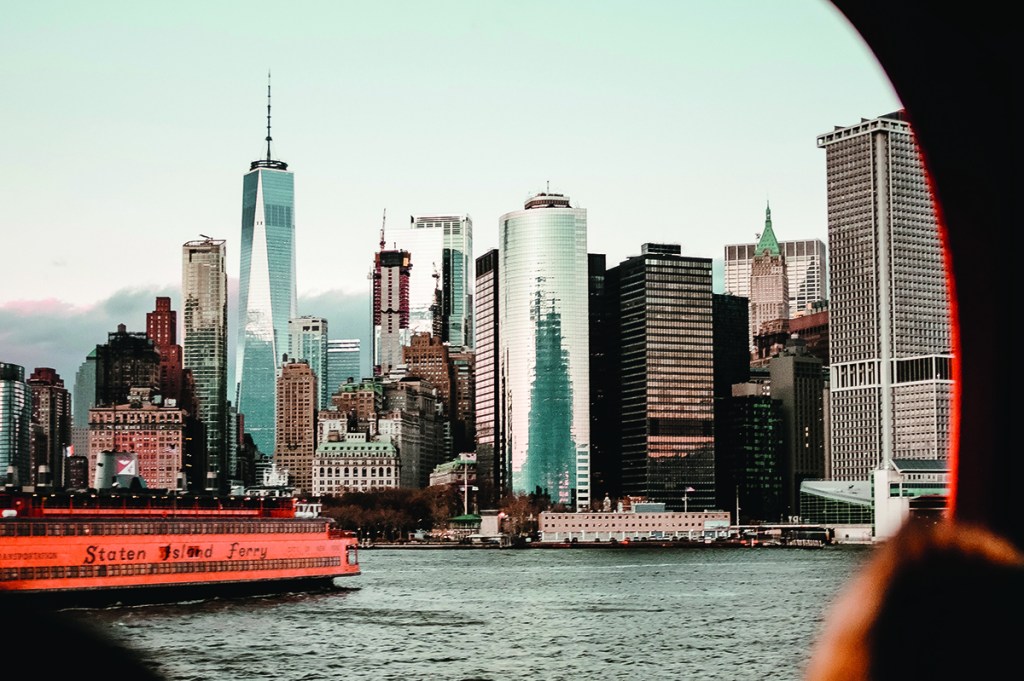The Margarita, the divey bar facing an equally divey pizza joint in the Staten Island Ferry Terminal, is a special place. For one, it’s where a middle-aged African-American lesbian bought me a drink — the only instance I can recall from decades of drinking that a woman has offered to buy me a drink before I got her one. Given her preference for fuller Latino ladies over lanky white men — which she emphasized through photos on her phone — my new acquaintance clearly didn’t have an agenda behind that drink for me. We just got talking and she did that New Yorker thing of embracing companionship and the moment.
There is a lot of that going on at the Margarita Bar and throughout the surrounding ferry terminal that is, in my opinion, New York’s finest and most underappreciated institution. When I made it back to the US after eighteen months of the travel ban on arrivals from the UK, I made a beeline for the ferry terminal at the southern tip of Manhattan to reconnect with the rich panoply of American life flowing by.
Staten Island offers the spiritual antonym to elitist performances such as the Met Gala and the Oscars that peddle a distortion of American life. Once you pass under the huge letters spelling STATEN ISLAND FERRY — each funkily ringed in neon blue — you encounter real New York and real people. The real US of A in all its absurdity, contradictions and pathos.
Construction workers pop into the Margarita Bar for a quick beer before beginning the night shift amid Downtown’s ever-rising buildings. Staff from nearby helicopter sightseeing tour companies prop up the bar after another frustrating day’s takings, bemoaning the lack of tourists compounded by greedy management maintaining too-high fees. Before ordering a stiff drink, a forty-year-old mother of eight sat on a bench outside swearing down her phone about her teenage son being jumped by a gang after his supposed girlfriend tipped them off.
;768:[300×250,336×280,320×100];0:[300×250,320×100,320×50]”]A dean and janitor from the same school knocked back whiskey shots together after a day spent dealing — for the dean — with students wrestling with sexual identities and pronouns and — for the janitor — with another restroom plumbing crisis. (The janitor has far less time for gender fluidity in the restroom; the crumbling pipes are challenge enough.) All the while, bankers, administrators, nurses, secretaries and service workers bounce in and out grabbing beers — the Lagunitas IPA from California appeared most popular — and cocktails to-go for their ferry ride toward Staten Island and home.
Another reason I admire the spot is because it offers a rare chance to do something in the Land of No Free Lunch entirely for free. You can take the twenty-five-minute ferry to Staten Island —giving some of the best views of the Statue of Liberty and Downtown’s skyscrapers — as many times as you want. In Boston, I met a sixty-nine-year-old lady who remembered when the ferry service had followed the usual capitalist course, costing a nickel, then a dime and then a quarter. But suddenly the city fathers in a rare moment of munificence went against the free-market grain and waived even that small fee.
At the bar, I learned a lot about Staten Island. It’s the most geographically disconnected of the city’s five boroughs, with just the ferry and the Verrazzano-Narrows Bridge connecting the eastern portion of the island to Brooklyn. More significantly, it’s the city’s conservative bastion, a black sheep of the family in a progressive Democrat-voting city. There are a lot of Trump voters in Staten Island — and they will still be there if he runs in 2024.
Open since 1905, according to New York City Department of Transport the ferry service carries approximately 25 million passengers annually on the 5.2-mile run between the Whitehall Terminal in Lower Manhattan and St George Terminal in Staten Island. The service runs 365 days a year, twenty-four hours a day. Five boats make 117 trips on a usual weekday, carrying approximately 75,000 passengers. Each ferry has a name. The newest is the Staff Sergeant Michael H. Ollis, named for a resident of Staten Island’s New Dorp neighborhood who was killed in Afghanistan in 2013 while saving the life of a Polish soldier, NYC DoT notes on its website. Being a naively romantic Americophile, and not wanting to dwell further on Afghanistan, I try to catch Spirit of America or John F. Kennedy. (Sandy Ground and Dorothy Day are to be added to the fleet next.)
Despite all the dispiriting signs on the mainland — rising homelessness and addiction, elites disconnected and uncaring, a nation ideologically divided — the US should be all right, so long as the Staten Island ferries are running for free and commuters are popping into the Margarita Bar after an honest day’s work for a beer or a Long Island Iced Tea to take the edge off as the Statue of Liberty passes by.
;768:[300×250,336×280,320×100];0:[300×250,320×100,320×50]”]This article was originally published in The Spectator’s January 2022 World edition.

























